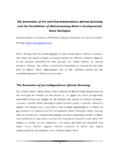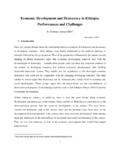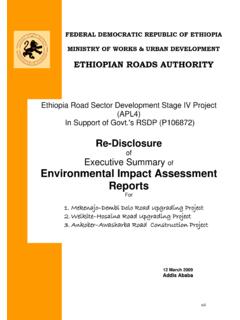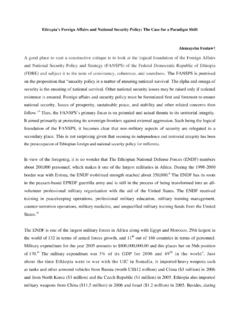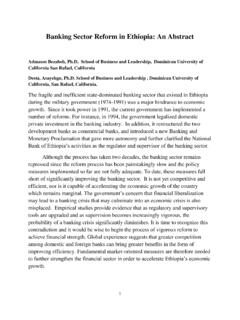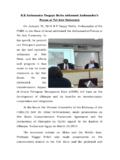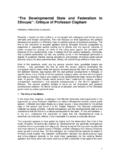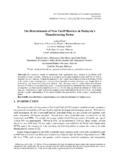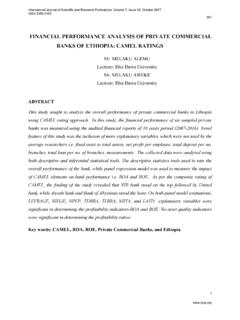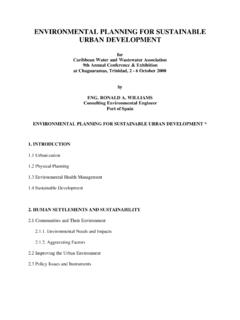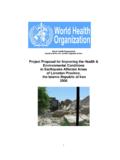Transcription of Population Growth and Economic Growth in Ethiopia
1 The Elephant in the Room: Population and Economic Growth Discourse in Ethiopia Tsegaye Tegenu October 27, 2011. The world's 7 billionth baby will be born on 31 October 2011. Researchers, policymakers, governments, civil society and social medias are expressing their concern over the effects of an ever increasing number of people on the planet and the greater demand on food, healthcare, education and jobs. According to the recent report released by UNFPA. ( ) most of the Population Growth is occurring in developing countries and it is these countries which are affected most by the Growth .
2 Ethiopia is featured in the report and by 2050 Ethiopia 's Population is projected to reach 174 million to become the 9th largest country in the world. Taking the opportunity of the UN announcement of the seven billion people of the planet, I would like to reflect on our understanding of the Population Growth problem in Ethiopia and how our knowledge about the problem is manifested in policy formulation and narratives. Since time and space do not allow me to dwell on the state of our knowledge, I will cite some examples to show the changes in our line of thinking. In April 2001, Addis Ababa, the capital city, was engulfed for two days by student and non-student urban youth revolts.
3 Following this revolt, for almost two years, the highly densely populated area of southern Ethiopia saw a number of repeated and continuous revolts spearheaded by students. Knowing the threats posed to the young adults, at that time, almost ten years ago, I raised the Population issue with some government policy advisors. By then there seemed to be a consensus that Population Growth would take care of itself if the government focus on Economic Growth and development. There was a belief that Population 1. problem will solve by itself if the government invests much in education, health and other development activities.
4 In other words Economic Growth and development will solve the problem and I was assured not to worry about. Knowing the riot signals made by the urban youth, I was surprised to learn why the Population issue did not receive the necessary attention it deserved. I found out that there were two main reasons. First, raising the issue of Population Growth was erroneously considered as distribution of contraceptives and introducing of Population control programs. Since family planning is a private matter, Population issue was considered sensitive intruding on privacy. As I tried to explain in different occasions, this was a wrong understanding of the issue.
5 Speaking about Population Growth /pressure means speaking about the type of Population that is increasing, its size multiplied by its needs, and the speed at which it is increasing ( Growth rate). The second reason, following the first, was the lack of knowledge in understanding the link between Population Growth and Economic development. At the time of my discussion, both in policy and academics, Population Growth was either left in abeyance or mentioned peripherally as background factors. In the academic research community, compared to the magnitude of the problem, there were few researches specifically addressing Population change, dynamics and consequences.
6 The few studies conducted at that time dealt with mainly the impact of Population Growth on the environment, as a cause to land fragmentation and change in livelihood strategies. What was surprising about these studies was that how the researchers found solution to the problems they were studying. Often the driving force, the Population factor, was forgotten or glossed over when finding solutions and recommendations. For instance, in the case of land tenure system, while the Population factor is admitted as the driving force behind fragmentation, the solution to further fragmentation is sought on ways of securing the tenure systems such as call for privatization of land.
7 In other 2. words, researches were finding solutions to the symptoms, not to the root causes of the problems. There was a tendency to see the rural households as static. As I mentioned in my previous postings, early household formation and the increase in the proportion of marriage multiplies the number of households over time. Change in tenure system alone (access to land and security) cannot solve output problems caused by household multiplication and growing rural surplus labor. The level, timing and distribution in the factors of household dependency ratio, density ratio and rural surplus labour continuously affect capability and factor ratios in rural areas.
8 Today both policy makers and the academicians are convinced theoretically and empirically about the burden of Population , especially at the stage it finds itself now. The government National Population Policy is being implemented by NGOs, with different size and capacity and interest. The benefits of Population policy include programs affecting mortality (immunization, reduction of child and maternal health, provision of health services, HIV/AIDs, etc.) and fertility (family planning, status of women, contraceptives, family education, family law, etc). Since the government lack resources, family planning and other Population control measure activities are done by NGOs.
9 Even if this Population policy is implemented it will not pull out the country from its current level of development. What the Population policy is actually doing is to relief the child burden and at the same time to increase the number of the young adult group. A decline in fertility and a reduction in the total number of children born create a bulge of young adult group. The proper implementation of the Population policy creates further demand on education, jobs, housing and other related infrastructure investment problems. There is a need to go beyond the Population policy and try to find ways on how to operationalize Population Growth in development planning.
10 3. In the past decade attempts have been made to show the major impacts of Population Growth on development. However, there are signs which show that the Population Growth problematic is not yet taken sufficiently in accounting development policy and planning. That Population Growth is not yet concretely operationalized at the level of development policy can be seen from the current discussion on Economic Growth . In Ethiopia Economic Growth is discussed without considering the consequences of Population Growth . We read reports that the country has experienced strong Economic Growth measured in terms of GDP.
